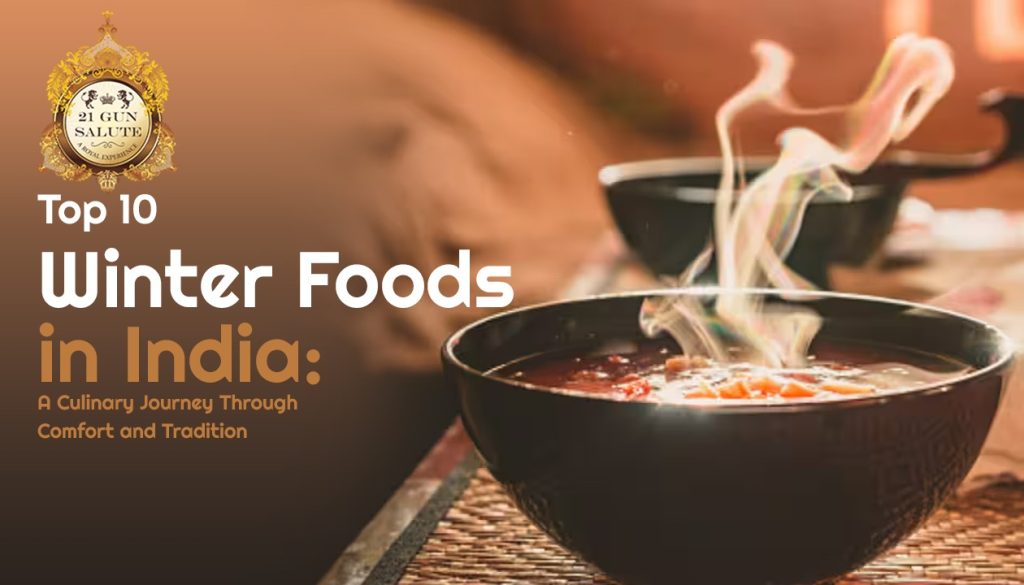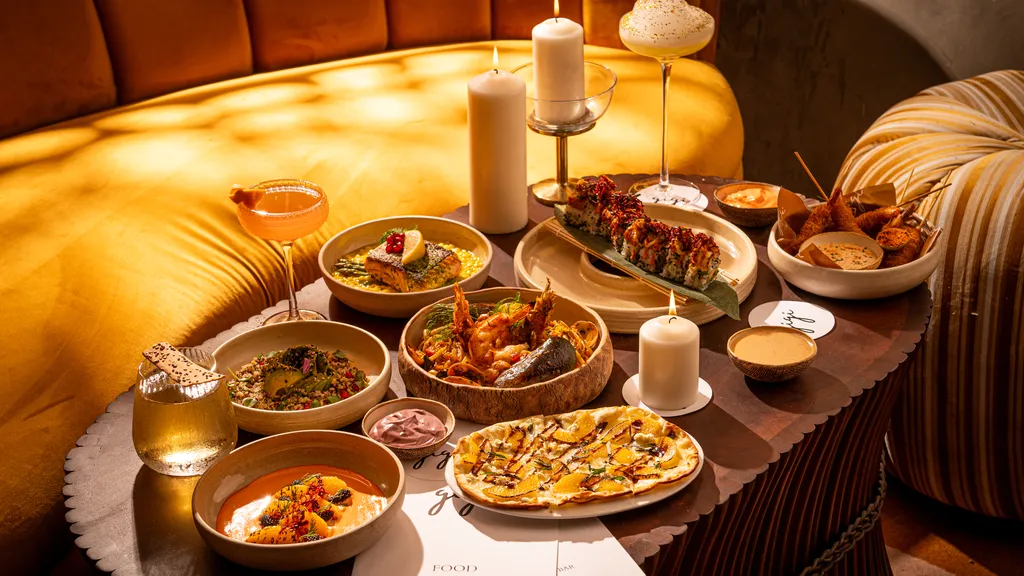India’s kitchens come alive with simmering soups, sizzling parathas, delicious jaggery, along with a wealth of seasonal, fresh produce as the winter of 2026 sets in.
Indian winters are identified by eating of traditional dishes that nourish the body, boost immunity, and honour generations of cultural experience. They are much more than just warm shawls for freezing mornings.
Winter in India brings a delightful variety of seasonal foods that are not only comforting but also packed with essential nutrients to keep you warm and healthy. From hearty soups to traditional sweets, winter cuisine in India is a perfect blend of taste and wellness. In this post, we’ll explore the Top 10 Winter Foods in India that you must try to make the most of this cozy season. As the chill of winter sweeps across India, the craving for heartwarming, soul-satisfying food rises like steam from a hot bowl of soup.
From the bustling streets of Delhi to the serene hills of the South, each region has its own unique way of embracing the season with delicious, seasonal specialties.
Imagine biting into a crispy Aloo Paratha with a dollop of butter, or savoring a bowl of Gajar ka Halwa so sweet it’ll make you forget all about the cold outside. Whether you’re indulging in a rich bowl of Undhiyu or savoring the spicy heat of Chili Paneer, winter foods in India bring a whole new level of comfort, nostalgia, and joy to your taste buds.
1. Gajar ka Halwa: Carrot Magic in Every Bite
“Who knew carrots could be so sweet? Gajar ka Halwa makes you forget that you’re technically eating vegetables. It’s like dessert that your mom can’t nag you about!”
Carrot pudding, or gajar ka halwa, is an ancient Winter Foods in India from North India. Cardamom and dried fruits are utilized to flavor the meal, which can be prepared with grated carrots, milk, sugar, and ghee. It’s a wonderful comfort dish for the chilly winter months consisting of the natural sweetness of the carrots and the richness of the ghee and milk. It is a healthy enjoyment as well as an honor since it is tasty and a great supply of vitamin A.
- Fun Fact: Did you know that Gajar ka Halwa was introduced to India during the Mughal era? It quickly became a royal favorite and has been a winter staple ever since!
- Interactive Element: Try This at Home! Add a twist to the traditional recipe by mixing in a pinch of nutmeg or a splash of orange zest for an extra burst of flavor.
Seasonal Tip: Use red, juicy carrots available in winter for the most authentic and flavorful Gajar ka Halwa.
2. Sarson da Saag and Makki di Roti: A Punjabi Warm Embrace
“Eating Sarson da Saag with Makki di Roti feels like getting a warm hug from a Punjabi grandma – the kind that insists you take a third helping.”
A wonderful Winter Foods in India is a comfort snack is this famous Punjabi dish. Makki di Roti, a form of flatbread made from maize flour, is accompanied with Sarson da Saag, a filling curry prepared with mustard greens and traditional spices. It’s a nutritious and mouthwatering lunch given the curry’s warmth and the roti’s crunch. To further emphasize the dish’s richness, it is often served with a dollop of ghee or white butter.
- Fun Fact: The mustard plant, known as “sarson” in Hindi, is also the source of mustard oil, which is commonly used in North Indian cooking.
- Interactive Element: Cooking Tip! Pair your Saag with a glass of lassi or buttermilk to balance the meal’s richness.
Seasonal Tip: Fresh mustard greens are abundant in winter, making this dish a seasonal star. Pair it with a dollop of white butter for added richness.
3. Undhiyu: Gujarat’s Vegetable Symphony
“Undhiyu is like a winter party in a pot—everything gets in, mingles, and comes out tasting fabulous.”
Gujarat is the location of undhiyu, a variety of vegetable curry that is frequently produced in the winter. It is created with a mix of spices and a variety of seasonal vegetables, notably beans, potatoes, sweet potatoes, and eggplant. Its taste has been improved by the reason that it frequently comes out in an earthen pot. Undhiyu, an appreciated Winter Foods in India, is often presented at festivals and family get-togethers and works well served with puris or rotis.
- Fun Fact: The name “Undhiyu” is derived from the Gujarati word “undhu,” which means upside down, referring to the traditional cooking method of placing the pot upside down in an earthen oven.
- Interactive Element: Create Your Own! Experiment with different seasonal vegetables available in your region to create your personalized version of Undhiyu.
Seasonal Tip: The best Undhiyu includes fresh, tender winter vegetables like purple yam, surti papdi, and green beans.
4. Pongal: Southern Comfort in a Bowl
“Pongal is the food equivalent of a cozy blanket on a cold day—comforting, warm, and impossible to leave once you’ve settled in.”
Pongal is a South Indian comfort nourishment that enjoys special attention during the Pongal festival and the Winter Foods in India. It can be made by cooking rice and lentils while adding cumin, ginger, and black pepper. Curry leaves, cashews, and ghee are often used to temper the meal, giving it a deep, fragrant taste. It is a soothing and filling dish that is suitable for the chilly winter days.
- Fun Fact: Pongal is not just a dish; it’s also the name of the harvest festival celebrated in Tamil Nadu, marking the end of the winter solstice.
- Interactive Element: Kitchen Challenge! Try making Sweet Pongal by adding jaggery, cardamom, and coconut for a festive twist.
Seasonal Tip: Use freshly harvested rice and moong dal for a Pongal that tastes as festive as the occasion it celebrates.
5. Methi Thepla: A Portable Winter Wonder
“Methi Thepla is the original grab-and-go food, proving that long before sandwiches, India had its portable meal game strong.”
Fenugreek leaves, wheat flour, and a number of spices are used to create the Gujarati flatbread that is called methi thepla. Known for their comforting qualities, fenugreek leaves are particularly valuable in the winter months because they can aid with cold protection and digestion. Methi Thepla frequently comes served with tea, yogurt, or pickles. It is a wonderful and nourishing breakfast or snack for its spicy spices and somewhat bitter taste.
- Fun Fact: Fenugreek leaves used in Thepla are known for their health benefits, including improving digestion and reducing inflammation.
- Interactive Element: Pack a Picnic! Roll up some Methi Theplas with a side of pickle and yogurt for a perfect winter picnic meal.
Seasonal Tip: Fresh fenugreek leaves available in winter add a vibrant flavor and health boost to your Theplas.
6. Aloo Paratha: The King of Comfort Foods
“Aloo Paratha is proof that stuffing carbs inside carbs is the universe’s way of telling us to indulge during winter.”
A standard North Indian meal that is loved all across the nation, particularly Winter Foods in India, is aloo paratha. This paratha, is made with whole wheat flour and filled with hot mashed potatoes, tastes best when served alongside a dollop of yogurt or butter. It is calming and nourishing, allowing you the energy you need to face the day. Aloo Paratha is an admired comfort dish during the winter months since it works well with pickles, raita, and a steaming cup of chai.
- Fun Fact: Aloo Paratha is so beloved in North India that there are even roadside stalls (dhabas) dedicated solely to serving this dish, often accompanied by a glass of creamy lassi.
- Interactive Element: Topping Time! Try topping your Aloo Paratha with grated cheese or a sprinkle of fresh herbs for a modern twist.
Seasonal Tip: Winter potatoes are naturally sweeter and creamier, making your Aloo Paratha filling irresistibly tasty.
7. Gulab Jamun: Sweet Bliss in Every Syrupy Sphere
“Gulab Jamun is what happens when dough decides to live its best life—fried to perfection and drenched in syrupy goodness.”
A regular Indian dessert, gulab jamun is often eaten all over the winter and on festive occasions. Made from khoya (reduced milk), these deep-fried dough balls are then coated in a sugar syrup fragrant with cardamom or rose water. The dessert is a rich, creamy delicacy that is especially delicious as the Winter Foods in India because of the warm syrup. Everyone loves this dish, that’s frequently consumed after a substantial dinner.
- Fun Fact: Originally, Gulab Jamun was made from khoya, but variations include using bread or milk powder, adapting to different regional tastes.
- Interactive Element: Sweet Experiment! Infuse the sugar syrup with saffron strands or rose petals for an aromatic delight.
Seasonal Tip: Keep Gulab Jamun warm during winter to enhance its soft, syrupy texture.
8. Paya Soup: Liquid Gold for Winter Nights
“Paya Soup is like a spa day for your insides—rich, nourishing, and a cure-all for everything winter throws at you.”
The trotters of lamb or goat can be utilized to create Paya Soup, an established winter snack that is slow-cooked with spices to make a tasty broth. Even the North and the South of India make this meal often, currently each area gives the recipe a different flavor. The collagen from the bones is extracted during the long simmering process, creating a rich and nutritious soup that is ideal for fortifying the body in the winter. It is often eaten with rice or naan.
- Fun Fact: Paya Soup is not just a winter delicacy but also a traditional remedy for joint pains and colds due to its collagen content.
- Interactive Element: Spice It Up! Add a squeeze of lemon or a dash of red chili flakes to customize the soup’s tang and heat to your liking.
Seasonal Tip: Slow-cook the soup to extract the maximum flavor and nutrients from the bones.
9. Tilgul: Tiny Treasures of Tradition
“Tilgul is like edible glitter—small, shiny, and it makes everything better, especially when you’re sharing it with friends.”
Commonly made during the Makar Sankranti holiday, which comes in the Winter Foods in India, tilgul is a traditional Maharashtrian treat. This confection, typically made from jaggery and sesame seeds (til), is said to contribute to wealth and good health. While jaggery contributes with improving blood circulation, sesame seeds are high in calcium and provide warmth. In light of this combination, tilgul is not solely an amazing snack but also a wintertime meal that keeps the body nourished.
- Fun Fact: Tilgul is exchanged during Makar Sankranti with the saying “Tilgul ghya, god god bola,” which translates to “Take this sweet and speak sweetly.”
- Interactive Element: DIY Sweet Treat! Make your own Tilgul at home and gift them to friends with a personalized note for a warm, sweet gesture.
Seasonal Tip: Prepare Tilgul fresh during Makar Sankranti to enjoy its crunch and flavor at their peak.
10. Chili Paneer: A Spicy Winter Romance
“Chili Paneer is what happens when Paneer decides it wants to live on the wild side—crisp, fiery, and always exciting.”
A recognized Indo-Chinese nourishment, chili paneer is a savory and spicy dish got ready with paneer, or Indian cottage cheese, mixed with a tasty sauce made with soy sauce, ginger, garlic, and green chilies. This supper is perfect for Winter Foods in India because of the crisp texture of the paneer cubes and the warmth of the spices. Both vegetarians and non-vegetarians like Chili Paneer, which is often served with fried rice or noodles.
- Fun Fact: Chili Paneer is a product of the Indo-Chinese culinary fusion, a cuisine developed by the Chinese community in Kolkata.
- Interactive Element: Heat Challenge! Adjust the spice level by adding more or fewer green chilies, and see who can handle the heat!
Seasonal Tip: Use fresh, firm paneer and adjust the chili to suit your winter heat cravings.
What is the best food to eat in winter?
Winter brings chilly temperatures, shorter days, and a natural craving for warm, comforting foods. Eating the right foods during winter not only keeps us warm but also helps boost our immunity, prevent seasonal illnesses, and maintain energy levels. The best winter foods are those that provide warmth, essential nutrients, and a sense of comfort. Here are some of the best foods to eat during winter:
1. Root Vegetables
Root vegetables like carrots, sweet potatoes, beets, and turnips are ideal for winter as they are rich in fiber, vitamins, and antioxidants. They help strengthen the immune system and keep the body warm. These vegetables can be roasted, made into soups, or added to stews.
2. Leafy Greens
Dark leafy greens such as spinach, kale, mustard greens, and fenugreek leaves are packed with vitamins A, C, and K, which support immunity and bone health. They are best consumed in soups, stir-fries, or as part of warm curries.
3. Soups and Broths
Hot soups and broths are perfect for winter as they provide warmth, hydration, and essential nutrients. Chicken soup, vegetable broth, and lentil soup are excellent choices as they are rich in protein, vitamins, and minerals that help fight colds and boost immunity.
4. Nuts and Seeds
Almonds, walnuts, cashews, and flaxseeds are packed with healthy fats, protein, and omega-3 fatty acids. These nutrients help in keeping the body warm, improving brain function, and maintaining skin health during dry winter months.
5. Seasonal Fruits
Fruits like oranges, apples, pomegranates, and kiwis are rich in vitamin C, which strengthens immunity and prevents winter infections. These fruits also provide antioxidants that promote healthy skin and overall well-being.
6. Whole Grains
Whole grains such as brown rice, oats, quinoa, and millet are excellent sources of fiber, protein, and essential nutrients. They help in keeping the body warm, providing long-lasting energy, and improving digestion. Oatmeal is a particularly good breakfast choice for winter.
7. Dairy Products
Milk, yogurt, and cheese are great sources of calcium and protein, which help in keeping bones strong and improving gut health. Warm milk with turmeric or ginger is a traditional winter drink that boosts immunity and prevents colds.
8. Spices and Herbs
Spices like ginger, turmeric, cinnamon, black pepper, and cloves have natural warming properties and help improve digestion, boost immunity, and prevent infections. Adding these spices to teas, soups, or curries can be highly beneficial.
9. Legumes and Pulses
Lentils, chickpeas, and black beans provide protein, fiber, and essential nutrients. They are great for keeping the body warm and energized during winter. Consuming them in soups, stews, or curries is highly recommended.
10. Hot Beverages
Herbal teas, green tea, and spiced teas like ginger tea or masala chai are great for keeping the body warm, improving digestion, and boosting immunity. These drinks also help in staying hydrated during winter.
Conclusion
Enjoy the cosy comfort and nourishment that such seasonal foods bring as you enter winter 2026 and cherish the amazing benefits of eating seasonal, fresh, and traditional foods.
As the chill of winter sets in, there’s no better way to embrace the season than with a spread of comforting, flavorful Indian dishes. From the rich, syrupy goodness of Gulab Jamun to the savory warmth of Sarson da Saag and Makki di Roti, these Winter Foods in India not only nourish the body but also warm the soul and also these are healthy foods to keep you warm this winter.
It’s like every dish tells a story one of tradition, flavor, and family gatherings.
Eating the right foods during winter helps maintain good health, boosts immunity, and keeps the body warm. Including seasonal vegetables, fruits, whole grains, nuts, dairy, and warming spices in your diet can make winter more enjoyable and nourishing.
So, the next time you’re cozying up in a blanket, let these Winter Foods in India be your invitation to indulge in the heart of India’s culinary treasures. Whether you’re diving into the hearty Undhiyu or savoring the spicy kick of Chili Paneer, winter in India is a time to celebrate food, family, and the simple joys of life.
Don’t just read about these dishes—grab a spoon, roll up your sleeves, and dive into the seasonal magic of India’s winter kitchens! After all, winter is not just about staying warm, it’s about savoring the food that makes the season special. 🍲
Let your winter of 2026 be warmed by these classic, wholesome foods that connect you with culture, comfort, and culinary excellence.
FAQs
1. What are the best winter foods?
The best winter foods are seasonal and warming like Root vegetables, leafy greens and jaggery are among the best winter foods because they are warming and in season.These cosy seasonal ingredients serve as the basis for many fine dining establishments, such as 21 Gun Salute.
2. How do these winter foods reflect 21 Gun Salute’s style?
Our restaurant draws inspiration from royal Indian cuisine, where traditional winter recipes have always played a central role. The use of premium spices, slow cooking, and heirloom vegetables is part of our heritage-driven culinary approach.
3. Does 21 Gun Salute use seasonal winter ingredients in its dishes?
Actually, 21 Gun Salute recognises the flavours and nutrients of the season by creating dishes involving warming winter spices and fresh seasonal produce.
4. Why are foods like saag, millet, and jaggery important in 21 Gun Salute’s menu?
These foods are valued by 21 Gun Salute because they have a strong Indian heritage and are used to make dishes that combine tradition, taste, and nutrition.
5. Can guests expect winter-inspired dishes at 21 Gun Salute?
Yes, 21 Gun Salute usually brings seasonal flavours to our lavishly inspired menu by taking inspiration from traditional Indian winter dishes.




